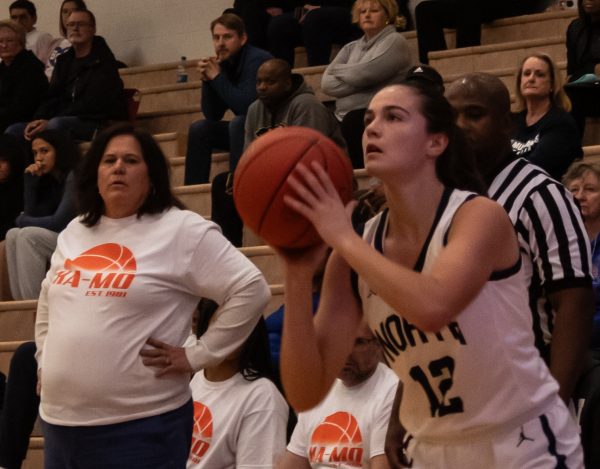Ruth Bader Ginsburg: Leaving Behind her Legacy
“When I’m sometimes asked, ‘When will there be enough [women on the Supreme Court]?’ and my answer is: ‘When there are nine.’ People are shocked. But there’d been nine men, and nobody’s ever raised a question about that.” – Ruth Bader Ginsburg
For 27 years, Ruth Bader Ginsburg served as a justice on the US Supreme Court, championing women’s rights and fighting for overall progress in the US. Ginsburg helped pass legislation to legalize same-sex marriages, legalize abortion, gain financial independence for women and more.
Throughout her life, Ginsburg overcame many obstacles. She came from a low-income neighborhood in Brooklyn, New York, and in both school and her career, she was often one of few women in male-dominated environments. According to NBC Boston, as a law student at Harvard University, Ginsburg was one of nine women in her class of over 500, and was asked by the dean at the time, how she justified taking the place of a man. After working as a lawyer and arguing several major cases before the Supreme Court, Ginsburg became the second woman and the first Jewish woman to serve on the US Supreme Court in 1993.
The news of Ginsburg’s passing on Sept. 18 led students and teachers in the BVN community to remember and celebrate her legacy. For some, Ginsburg’s passing also heightened anxious emotions for the upcoming election.
As a Jewish woman, junior Emma Jacobson said she could strongly connect to Ginsburg and saw her as a hero for both herself and other girls across the nation.
“I always kind of resonated with the fact that she was the minority,” Jacobson said. “People degraded her, called her bad words because she had that fire in her. And she didn’t listen to any of the men, she just kept going forward.”
In addition to being a women’s rights activist and a Supreme Court justice, Ginsburg became a pop-culture icon for younger generations. In 2013, a New York University law student posted on Tumblr calling Ginsburg the Notorious R.B.G., a spin on rapper Biggie Smalls’ nickname, the Notorious B.I.G. After catching nationwide attention, t-shirts, movies and stickers were made in Ginsburg’s honor.
“[Ginsburg] always had that young appeal,” Jacobson said. “She worked out everyday; she had a personal trainer; she would go to the opera. She kind of led a normal life. The fact that she was this trailblazer of a woman who was resilient and didn’t listen to anyone else, that’s why she served as such a role model for kids and teens.”
Ginsburg died at the age of 87, after being diagnosed with pancreatic cancer in 2009. Despite battling cancer over the years, Ginsburg did not stop working. According to CNN, in May of this year, Ginsburg participated in a teleconference hearing from a Baltimore hospital after undergoing treatment for a gallbladder condition. Jacobson said she admired this resilience in Ginsburg’s character.
“[After Ginsburg’s death,] my phone got so many notifications and I just couldn’t believe it,” Jacobson said. “It’s really scary to be a young woman right now in the political climate with the election coming up. My anxiety level is very high for [this election,] so I think that was the cherry on top. Her death was a wakeup call for me and for America that we have to register to vote and do all we can to continue her legacy as much as possible.”
BVN alumni Nicholas De’Souza said he admired the way Ginsburg spoke for those who could not speak for themselves, and without her, he worried about the future in terms of politics and progress.
“It was really devastating. I was pretty heart-broken,” De’Souza said. “I think for me, at first, it was like what do we do now? And how are the things she fought for going to be handled if we do replace her before the election?”
On Saturday, Sept. 26, President Donald Trump announced Amy Coney Barrett as his nominee to replace Ginsburg’s seat. According to the Washington Post, before Ginsburg’s passing, the political makeup of the court consisted of five conservatives and four liberals, including Ginsburg. If Barrett is confirmed, the court would have a clear conservative majority.
“I know that Amy has talked about not necessarily supporting LGBTQ rights and has been opposed to abortion and the Affordable Care Act,” De’Souza said. “Ruth Bader Ginsburg definitely fought for all of those, so it’s kind of undoing the things she has spent her entire life doing in the Supreme Court.”
In the days following Ginsburg’s death, there was a surge in voter registration, according to the spokesman of Vote.org. The site saw a 68% increase in voter registrations on the weekend following her passing than the previous week.
“I think that people are realizing, with her passing, that the policies that she fought for could be taken away so easily with her being gone,” De’Souza said. “…I feel like that serves as a catalyst towards especially the younger generation who are wanting to keep [Ginsburg’s] beliefs in our policies.”
History teacher and sponsor for the Feminism and Gender Equality club, Erica Benson, honored Ginsburg in the first Feminism and Gender Equality club meeting this year.
“For the club, she’s an example of fighting back, making incremental change,” Benson said. “Even though she would make a ruling, she [would say,] ‘This is just our ruling, now you should do this…’ So she was always kind of a step ahead. She clearly understood the legal system inside and out, and could guide the direction of advocates and legislatures who wanted to do more.”
As an activist and advocate for women’s rights herself, Benson said Ginsburg was a role model to her and made her feel represented on the Supreme Court.
“She gave more than just her time on the bench,” Benson said. “Any time she was in speaking engagements and talked about what it means to be a mom in America, a working mom. I think she’s just a great example of somebody who overcame hardship and despite the discrimination she faced, she achieved the highest court position possible, and excelled in that position and was very respected.”
In the span of her lifetime, Ginsburg launched the American Civil Liberties Union (ACLU) Women’s Rights Project, became a professor at Columbia University School of Law, was inducted into the National Women’s Hall of Fame, won the Berggruen Prize for Philosophy and Culture for her contributions to social justice and general equality, and the list goes on.
“Rarely, over the course of somebody’s life can you see such a rapid change in opportunity,” Benson said. “So when you’re feeling sad or upset or feeling like change isn’t happening, you can look at her lifetime and say look what happens if you keep working at it and you don’t give up, things can change.”













Elsie Weekes • Oct 12, 2020 at 5:29 am
To the writer, Yasmeen Saadi, this article represents a beautiful tributary of RBG’s life and her accomplishments. You, obviously, have been deeply touched by Ruth Bader Ginsburg as many others however you have managed to state your thoughts and feelings quite eloquently. Thanks for taking the time to express, publicly, what I am feeling.
buu long Tran • Oct 11, 2020 at 5:13 pm
A very strong , clear and concise write up of Ginsburg’s life at work with all the problems she meet . She easily solved thru her hard work and insight of the given situation . Her passing away is a waked up call to all Americans from all walks of life especially the youth , the future leaders of America . As the country is facing a tremendous problems locally and internationally , health problem , re Covid , trade , economy and politics etc…Yes thru education and hard work America will rise as the youth go forward to rebuilding the country , thru the guidance of the teachers .